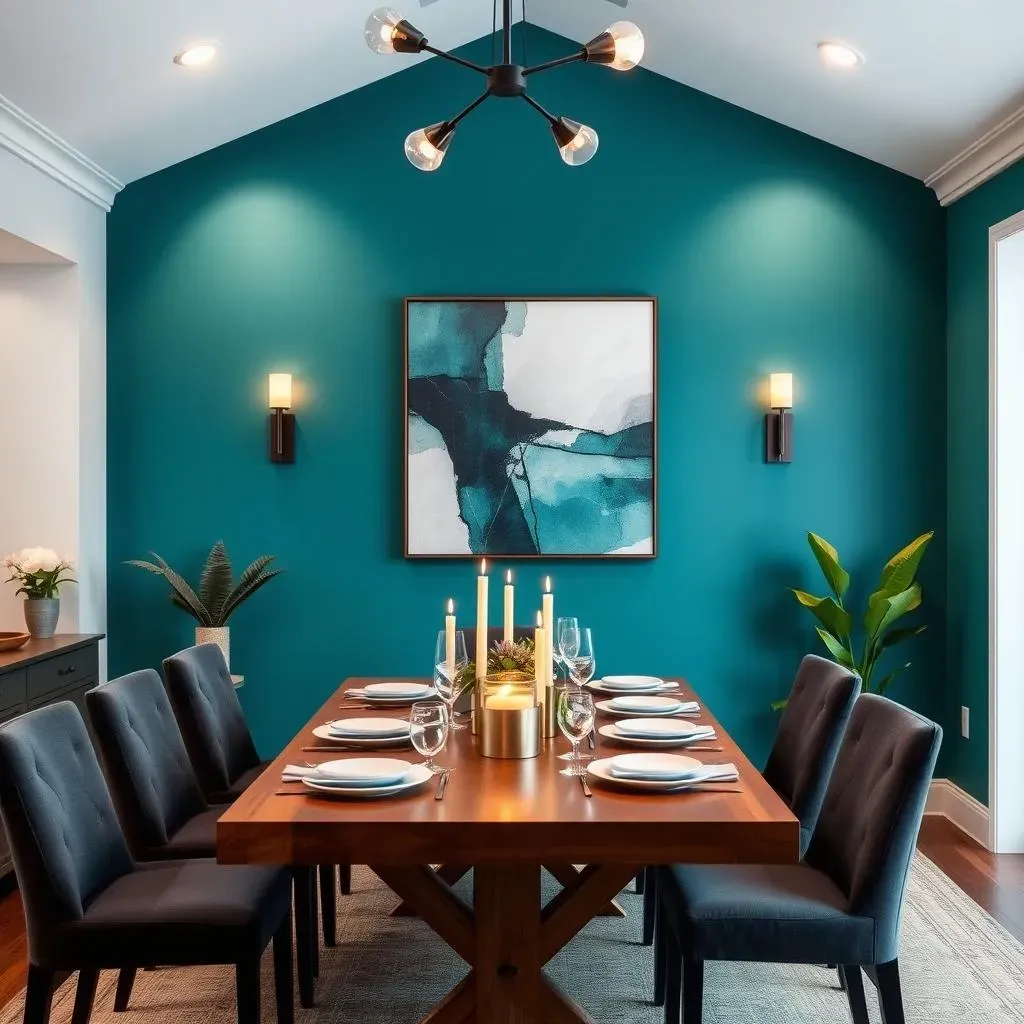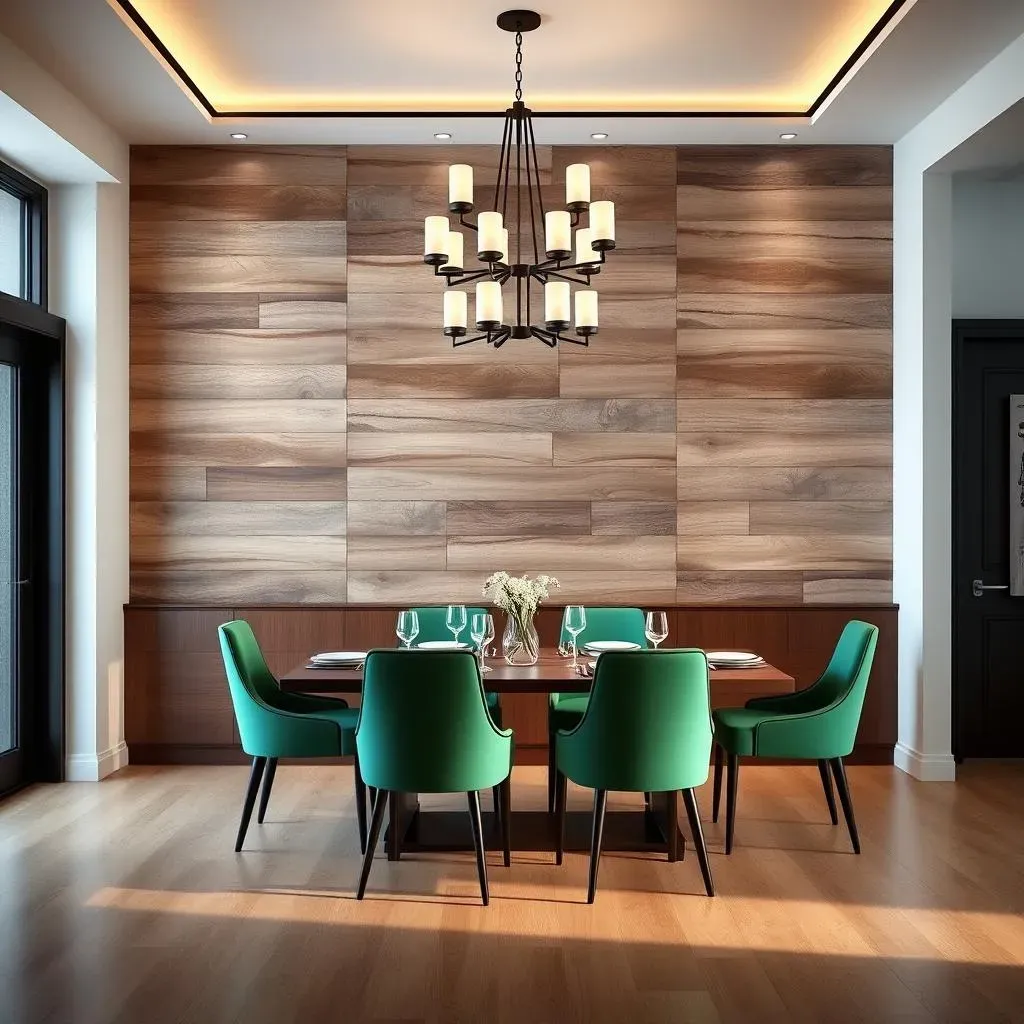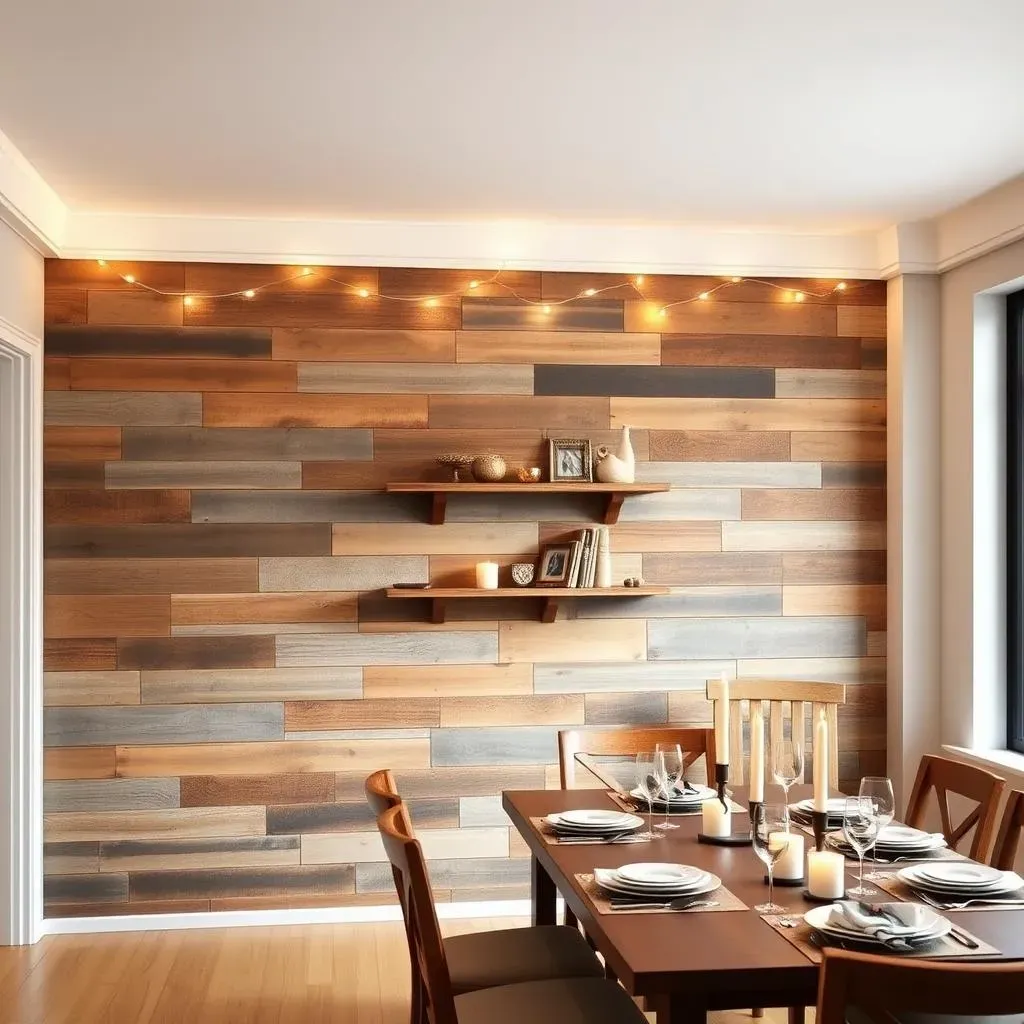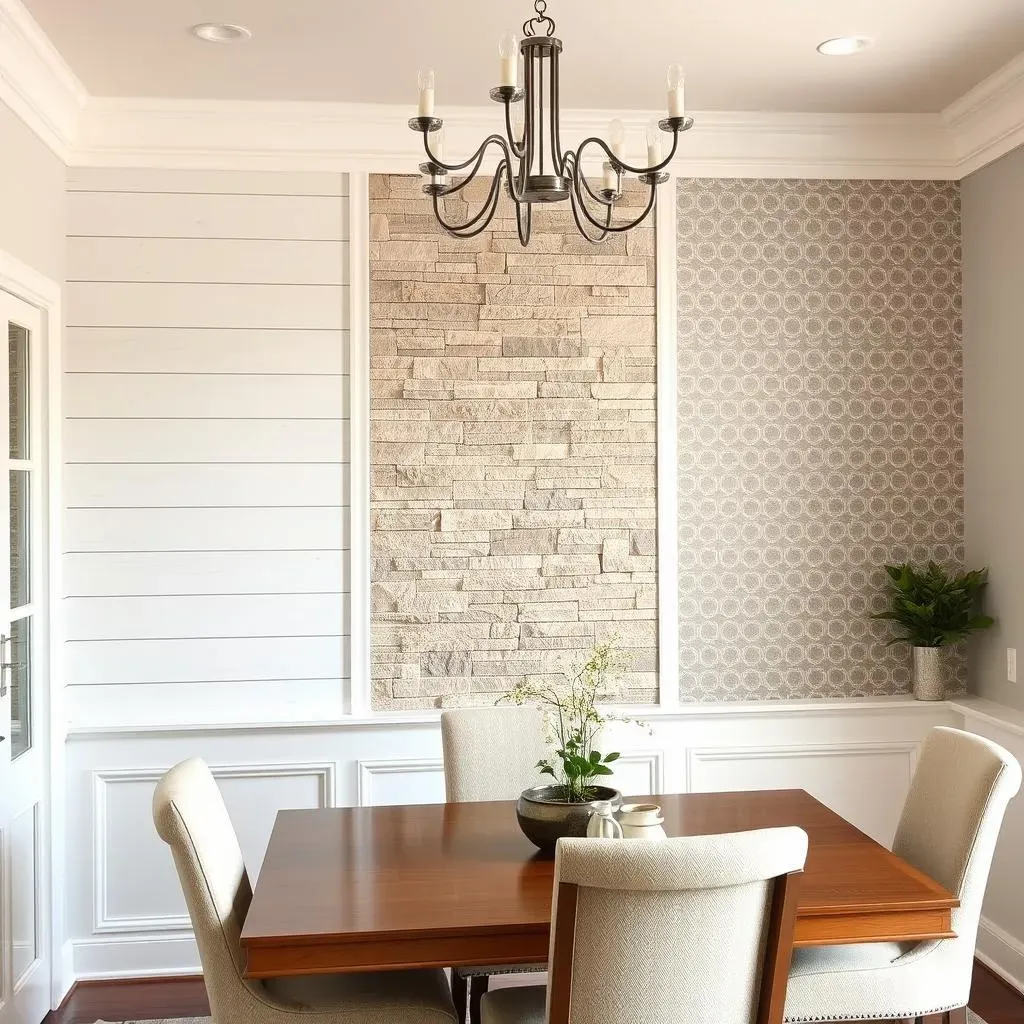Table of Contents
Is your dining room feeling a little…blah? A fresh coat of paint and a new centerpiece might help, but if you really want to inject some personality and visual interest, consider an accent dining room wall. It's a simple yet effective way to transform the entire space, creating a focal point that draws the eye and sets the mood. This article is your guide to unlocking the potential of your dining room. We'll explore why an accent wall is such a game-changer, dive into creative ideas to spark your imagination, and even offer some DIY tips to get you started. Whether you're a seasoned decorator or just dipping your toes into the world of interior design, you'll find inspiration and practical advice to create an accent dining room wall that reflects your unique style. From bold colors and captivating patterns to textured materials and personalized art, we'll cover it all. So, grab a cup of coffee, get comfortable, and prepare to be inspired to revamp your dining area with a stunning accent dining room wall.
Why Choose an Accent Dining Room Wall?

Why Choose an Accent Dining Room Wall?
So, why even bother with an accent wall in your dining room? Well, imagine walking into a space that instantly feels more inviting, more stylish, and more…you. That's the power of a well-executed accent wall. It's not just about slapping on a different color; it's about creating a focal point that elevates the entire dining experience. Think of it as the statement piece that ties everything together, showcasing your personality and design flair. It is also a relatively inexpensive method to bring a dramatic change in the interior.
- Visual Interest: Breaks up monotony and adds depth.
- Defines Space: Highlights the dining area, especially in open-concept homes.
- Expresses Style: Showcases your personality and design preferences.
- Increases Value: A well-designed accent wall can boost your home's appeal.
Creative Accent Dining Room Wall Ideas

Creative Accent Dining Room Wall Ideas
Bold Colors and Patterns
Ready to make a statement? Don't be afraid to go bold with your accent dining room wall. Think deep jewel tones like emerald green, sapphire blue, or ruby red for a touch of drama. Or, if you're feeling adventurous, try a vibrant wallpaper with a geometric pattern, floral design, or even a mural. The key is to choose a color or pattern that complements your existing decor but still stands out as a focal point. Consider the overall style of your dining room – is it modern, traditional, bohemian? Let that guide your decision-making process.
For a more subtle approach, consider using textured paint or wallpaper. These options add depth and visual interest without overwhelming the space. Think grasscloth wallpaper for a natural, organic feel, or a textured paint technique like Venetian plaster for a touch of elegance. And remember, lighting is key! Experiment with different light sources to highlight the texture and bring out the best in your accent wall.
Color/Pattern | Style | Best For |
|---|---|---|
Emerald Green | Traditional/Eclectic | Creating a luxurious, inviting atmosphere |
Geometric Wallpaper | Modern/Mid-Century | Adding a bold, graphic statement |
Grasscloth Wallpaper | Bohemian/Coastal | Bringing a natural, textured element |
Wood and Natural Elements
If you're looking to add warmth and texture to your dining room, consider using wood or other natural elements for your accent dining room wall. Reclaimed wood planks can create a rustic, farmhouse vibe, while a sleek wood paneling can add a touch of modern sophistication. You could even create a living wall with plants, bringing a touch of nature indoors. Imagine dining surrounded by lush greenery – talk about a conversation starter!
Another option is to use stone or brick veneer. These materials add a sense of permanence and texture to the space. A brick accent wall can create an industrial-chic look, while a stone veneer can add a touch of rustic elegance. Just be sure to consider the weight and installation requirements before you commit to a particular material.
DIY Accent Dining Room Wall Projects

DIY Accent Dining Room Wall Projects
Pallet Wood Wall
let's get crafty! A pallet wood wall is a fantastic way to add rustic charm to your dining room without breaking the bank. You can often find pallets for free or at a very low cost from local businesses. The key is to properly clean and sand the wood to remove any splinters or rough edges. Then, get creative with the arrangement! You can create a uniform pattern or a more random, eclectic look. Stain the wood in different shades to add depth and visual interest. This DIY project is all about embracing imperfections and creating a truly unique statement piece.
Once your pallets are prepped, grab some construction adhesive and nails to secure them to the wall. Make sure to use a level to ensure everything is straight! For a finishing touch, consider adding some fairy lights or small shelves to display your favorite decor items. This project is not only budget-friendly but also a great way to recycle and repurpose materials.
Safety Tip: Always wear gloves and a mask when working with wood, especially if it's reclaimed. And be sure to properly dispose of any waste materials.
Painted Geometric Designs
Want something modern and eye-catching? A painted geometric design is the way to go! This project is all about precision and creativity. Start by choosing a color palette that complements your existing dining room decor. Then, use painter's tape to create a geometric pattern on your wall. Triangles, squares, and hexagons are all popular choices. Once you're happy with the design, start painting! Use a small brush or roller to apply the paint, making sure to stay within the taped lines. Peel off the tape while the paint is still slightly wet to avoid chipping. The result? A stunning, custom-designed accent wall that will impress your guests.
Don't be afraid to experiment with different colors and patterns! You can create a bold, graphic statement or a more subtle, understated design. Consider using metallic paint for a touch of glamour, or try a gradient effect for a more sophisticated look. The possibilities are endless!
Pro Tip: Use a laser level to ensure your lines are perfectly straight. This will make the project much easier and the result will be more professional.
Fabric Wall Hanging
Looking for a softer, more textural approach? A fabric wall hanging is a great option! This project is perfect for renters or anyone who wants to add a temporary accent wall without making any permanent changes. Simply choose a fabric that you love – think velvet, linen, or even a tapestry – and hang it on the wall using a curtain rod or dowel. You can also create a custom fabric wall hanging by sewing together different pieces of fabric or adding embellishments like tassels or beads.
A fabric wall hanging can add warmth, texture, and personality to your dining room. It's also a great way to cover up any imperfections on the wall. Consider using a patterned fabric to add visual interest, or choose a solid color to create a more calming and serene atmosphere. And don't forget about lighting! Use spotlights or sconces to highlight the fabric and bring out its texture.
Budget Tip: Check out your local thrift store or fabric store for discounted fabrics. You can often find amazing deals on remnants and end-of-bolt pieces.
Choosing the Right Materials for Your Accent Dining Room Wall

Choosing the Right Materials for Your Accent Dining Room Wall
Color Considerations
Selecting the right color is paramount for your accent dining room wall. Think about the existing color palette in your dining room. Are you aiming for a complementary hue that blends seamlessly or a contrasting shade that pops? Darker colors can add drama and intimacy, while lighter colors can create a more spacious and airy feel. Consider the amount of natural light your dining room receives. A dark color in a dimly lit room might make the space feel too closed in, while a bright color in a sunny room could be overwhelming. Don't forget to test paint samples on your wall before committing to a full application! Live with the samples for a few days and observe how they look in different lighting conditions.
Also, it's important to consider the psychological effects of different colors. Blue is often associated with calmness and serenity, while red is associated with energy and passion. Choose a color that aligns with the mood you want to create in your dining room. And remember, you don't have to stick to just one color! Consider using a combination of colors to create a more dynamic and interesting accent wall. For example, you could paint a geometric pattern using two or three different colors, or you could create a gradient effect by blending different shades of the same color.
Texture and Dimension
Beyond color, texture plays a crucial role in creating a captivating accent dining room wall. Think about adding dimension with materials like wood, stone, or even textured wallpaper. A shiplap wall can create a rustic, farmhouse vibe, while a stone veneer can add a touch of natural elegance. Textured wallpaper can add subtle depth and visual interest without overwhelming the space. Consider using a combination of different textures to create a more dynamic and tactile experience. For example, you could pair a smooth, painted wall with a rough, reclaimed wood frame. Or, you could use a textured wallpaper with a subtle pattern to add depth and visual interest.
When choosing textured materials, it's important to consider the overall style of your dining room. A sleek, modern dining room might benefit from a smooth, minimalist texture, while a rustic, farmhouse dining room might benefit from a more rough and natural texture. Also, consider the maintenance requirements of different materials. Some textured materials, like brick or stone, may require more cleaning and upkeep than others. Choose a material that fits your lifestyle and your willingness to maintain it.
Material | Texture | Style | Maintenance |
|---|---|---|---|
Shiplap | Horizontal planks, slightly textured | Farmhouse, Coastal, Rustic | Easy to clean, occasional dusting |
Stone Veneer | Rough, natural stone | Rustic, Traditional, Modern | Requires sealing, occasional cleaning |
Textured Wallpaper | Various textures, from subtle to bold | Versatile, adapts to various styles | Easy to clean, some textures more delicate |
Material Durability and Cost
Before diving headfirst into your accent dining room wall project, assessing the durability and cost-effectiveness of your chosen materials is key. Some materials, like solid wood or natural stone, offer exceptional longevity but come with a higher price tag. Others, like pallet wood or certain wallpapers, are more budget-friendly but may require more frequent maintenance or replacement. Consider your long-term goals for the space. Are you looking for a permanent, investment-worthy feature, or a temporary, easily changeable accent? This will help you prioritize durability versus cost.
Furthermore, think about the potential for wear and tear in your dining room. If you have young children or pets, you might want to opt for materials that are easy to clean and resistant to scratches or stains. For example, a painted wall with a washable finish is a great option for high-traffic areas. If you're planning to install a wood accent wall, consider using a durable sealant to protect the wood from moisture and damage. Ultimately, the best material for your accent wall will depend on your budget, your style preferences, and your lifestyle.
Final Thoughts: Your Perfect Accent Dining Room Wall Awaits
Creating the perfect accent dining room wall is all about expressing your personal style and enhancing the ambiance of your dining space. From bold and dramatic statements to subtle and textured additions, the possibilities are truly endless. By carefully considering the color, material, and design that best complements your existing decor, you can transform your dining room into a captivating and inviting area for family and friends to gather. So go ahead, unleash your creativity and embark on this exciting design journey to create an accent dining room wall that you'll love for years to come.
